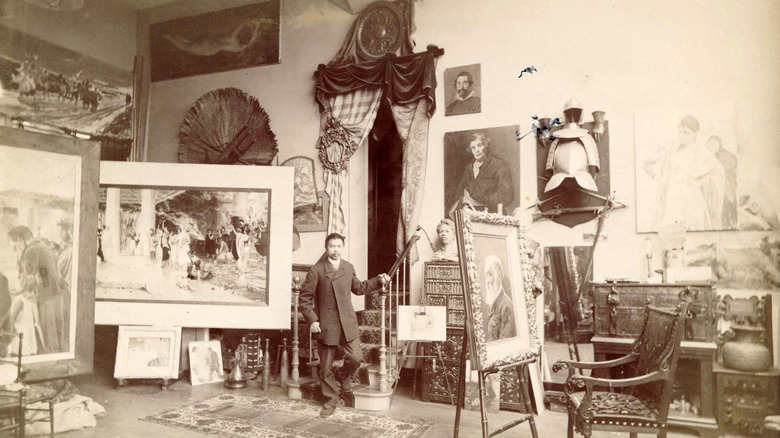Why People Think This Juan Luna Painting Is Cursed
If you're a skeptic, so-called "curses" are not real and can easily be explained away by bad timing, coincidence, or the misinterpretation of key facts. For example, the Bermuda Triangle has been associated with "mysterious" disappearances of ships and aircraft for decades; in fact, that region of the ocean covers major port and tourist cities, as well as major shipping lanes, and sees no more such incidents than any other similarly-busy plot of the ocean, according to History. Of course, if you're a believer, curses are real and there are steps that can be taken to reverse them.
History is filled with stories of not just cursed places, but cursed objects. For example, at least 10 people, according to Mental Floss, have suffered in some way or another due to the Hope Diamond. Similarly, a museum in England contains a supposedly-cursed chair, mounted high on a wall so no one can accidentally sit on it and curse themselves.
One cursed painting (there are several) is a beautiful portrait of a woman at rest, and nothing about it looks even remotely sinister. However, it was born out of violence and rage, and according to Owlcation, people who have owned it or crossed paths with it have suffered terrible fates.
'Portrait of a Lady' — 'Mi Novia'
The painting in question is called "Portrait of a Lady" — or alternately, "Mi Novia" (meaning my girlfriend or my betrothed, depending on the translation). Juan Luna (pictured above) was a skilled painter, but he was ... not a good man (at least, certainly not by 21st-century standards). According to Esquire, he was a jealous, hot-tempered, and violent man, not above beating his partners within an inch of their life if they crossed him. He met Paz Pardo de Tavera in Paris sometime before 1886, married her that year, and murdered her in 1892.
We'll spare you the graphic details of their marriage; suffice it to say it was dysfunctional and abusive. And it came to a head on September 23, 1892, when an enraged Luna showed up where his estranged wife was staying with one of her brothers. The brother was not home, but per Esquire, Paz's son and her mother, Juliana, were there. He shot Juliana, who died instantly. Paz died a couple of days later.
What does this have to do with the painting? The subject of Portrait of a Lady is probably Paz, although liberties appear to have been taken with her appearance (the woman in the painting has fair European skin, while Paz herself had a darker skin tone). The subject may have been a model, or the painting may simply be an idealized depiction of what he thought the perfect woman might look like.
Tragedy After Tragedy
Today, according to Esquire, the painting hangs in the National Museum in Manila. That's probably for the best, considering that in the three decades during which it was in private hands, tragedy befell just about everyone who came into contact with it.
According to Owlcation, the first person to own the painting was a businessman named Manuel Garcia, who went bankrupt after bringing home the painting. Esquire reported the next owner was in a "tragic" car wreck. Another owner's home burned down while the painting hung there — somehow the painting was not damaged. Vicky and Tony Nazareno owned the painting for a time in the 1980s. Tony started having serious health problems shortly after they acquired the painting. The next owner had a miscarriage while the piece hung in her home. Art restoration expert Susano "Jun" Gonzales, who is believed to have done "some work" on the painting, died in a gruesome murder. And in a final show of its cursed-ness, on the night the painting debuted in 1987 at the National Museum, the spotlight that shone on it exploded, while all of the other lights in the building functioned normally.
So what does this all mean? Everything or nothing, depending on your point of view. If it is truly cursed (and confirming or denying this is a bit outside of our lane), then it certainly belongs in a museum (though even there, it appears to exude its bad mojo). If it's not, then all of this tragedy that surrounds it is merely an unrelated series of events, the only common thread between them being the painting.


